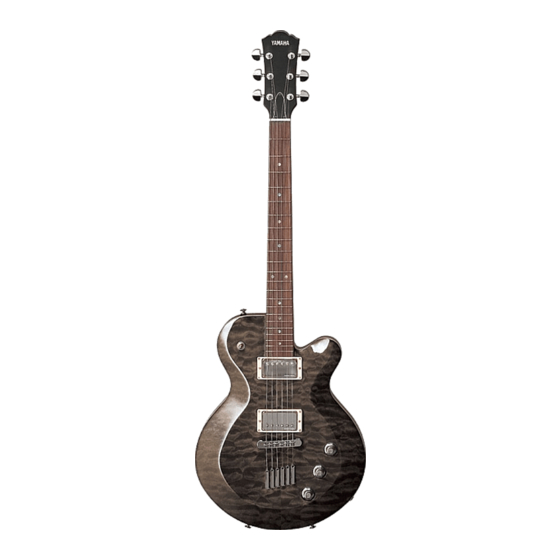Advertisement
Table of Contents
- 1 Table of Contents
- 2 Care and Maintenance
- 3 Tuning Machine Tension Adjustment
- 4 Height Adjustable Locking Nut
- 5 Setting the String Action
- 6 VIBRATO SYSTEM Vintage Type
- 7 VIBRATO SYSTEM Locking Type (Part 1)
- 8 VIBRATO SYSTEM Locking Type (Part 2)
- 9 Bridge/Spring Tension Adjustments
- 10 Truss Rod Adjustment
- 11 Pickup Height Adjustment
- 12 Correct Use and Handling of Batteries
- 13 Safety Precautions
- Download this manual
ELECTRIC GUITAR
CARE AND MAINTENANCE ................................................ 2
TUNING MACHINE TENSION ADJUSTMENT ...................... 3
HEIGHT ADJUSTABLE LOCKING NUT ............................... 3
SETTING THE STRING ACTION ......................................... 4
VIBRATO SYSTEM Vintage Type ........................................ 5
VIBRATO SYSTEM Locking Type (part 1) ........................... 6
OWNER'S MANUAL
CONTENTS
VIBRATO SYSTEM Locking Type (part 2) ........................... 7
BRIDGE/SPRING TENSION ADJUSTMENTS ...................... 8
TRUSS ROD ADJUSTMENT ............................................... 9
PICKUP HEIGHT ADJUSTMENT ........................................ 9
CORRECT USE AND HANDLING OF BATTERIES ............. 10
Safety Precautions ............................................................ 11
1
Advertisement
Table of Contents

Summary of Contents for Yamaha AES920
-
Page 1: Table Of Contents
ELECTRIC GUITAR OWNER’S MANUAL CONTENTS CARE AND MAINTENANCE ..........2 VIBRATO SYSTEM Locking Type (part 2) ......7 TUNING MACHINE TENSION ADJUSTMENT ...... 3 BRIDGE/SPRING TENSION ADJUSTMENTS ...... 8 HEIGHT ADJUSTABLE LOCKING NUT ....... 3 TRUSS ROD ADJUSTMENT ..........9 SETTING THE STRING ACTION ......... -
Page 2: Care And Maintenance
Congratulations on your purchase of the YAMAHA electric guitar. After playing, wipe the entire guitar down, including strings, With reasonable care, your YAMAHA elec- with a good polishing cloth. This will remove corrosive skin oils and acids, and protect the plating, finish, and strings. -
Page 3: Tuning Machine Tension Adjustment
TUNING MACHINE TENSION ADJUSTMENT HEIGHT ADJUSTABLE LOCKING NUT The tuning machines have spring-loaded mechanisms which 1) Remove 3 pcs. of hexagonal screws fixing the Lock Pads. automatically take up wear, preventing backlash. However, it is (illustration — A) possible to adjust the amount of pressure required to turn the 2) Loosen 4 pcs. -
Page 4: Setting The String Action
SETTING THE STRING ACTION — Bridge — Height adjustment screws (for each strings) NOTE: Be sure to perform any necessary adjustments to the truss rod before performing the following adjustments. String height refers to the space between the strings and frets, and has an affect on playability. -
Page 5: Vibrato System Vintage Type
VIBRATO SYSTEM Vintage Type Following is the procedure for adjusting the vintage vibrato To check intonation, compare the harmonic tone (12th fret) to system: the fretted tone (12th fret). ● If fretted pitch is higher than harmonic, saddle must be moved backward to lengthen string. -
Page 6: Vibrato System Locking Type (Part 1)
VIBRATO SYSTEM Locking Type (part 1) When changing strings it is necessary to cut off the ball ends 7) Lock the strings above the nut. (illustration — A) of the strings. 8) Use the fine tuning thumb screw to tune the guitar to the Following is the procedure for changing strings and adjusting correct pitch. -
Page 7: Vibrato System Locking Type (Part 2)
VIBRATO SYSTEM Locking Type (part 2) Intonation Adjustment in Vibrato Bridge Tighten 1) Loosen the hexagonal screw located in front of each saddle using the supplied hexagonal wrench. (illustration — D) Lower 2) Slide the saddles by hand to adjust the length of each string. -
Page 8: Bridge/Spring Tension Adjustments
BRIDGE/SPRING TENSION ADJUSTMENTS For best results the bridge should always be adjusted so it is parallel to the top surface of the guitar as shown in illustra- tion (below). This position is maintained by opposing tension between the strings and the claw springs. If you change string gauge, you will need to readjust the spring tension to return the bridge back to the parallel position. -
Page 9: Truss Rod Adjustment
TRUSS ROD ADJUSTMENT PICKUP HEIGHT ADJUSTMENT The curvature of the neck should be slightly concave. The height of the pickup (i.e. distance from the strings) affects Clockwise rotation of the nut tightens the rod and corrects for gain — the higher the pickup, the louder the sound, and vice too much concave bow. -
Page 10: Correct Use And Handling Of Batteries
CORRECT USE AND HANDLING OF BATTERIES Battery (6LR61 : 9V, S-006P) When these run out, don’t just Battery throw them away, but dispose of (6LR61 : 9V, S-006P) them as minor chemical waste. * When changing batteries, pay close attention to the +/- polarity markings as shown in the illustration above. -
Page 11: Safety Precautions
Safety Precautions Caution stock, be careful not to injure yourself on the sharp string ends. Using your Yamaha Guitar in a Safe Manner Preventing Unexpected Injuries and Accidents Using Batteries Properly • When using a strap, make sure the strap is se- •... - Page 12 Preventing Electrical Accidents Be Careful When Handling and Other Cautions • If the instrument must be used outdoors in bad weather, or in a place with • The guitar has been properly adjusted before being shipped from the facto- high humidity, please use caution. Please read the Owner’s Manuals that ry.
- Page 13 Yamaha Representative Offi ces in Europe AUSTRIA SLOVAKIA FINLAND ICELAND LUXEMBOURG Yamaha Music Europe GmbH (For Musical Instrument) (For Musical Instrument) Yamaha Music Europe Yamaha Music Europe GmbH Branch Austria (Central and Eastern Europe) Branch Austria F - Musiikki OY...
- Page 14 En caso de requerir alguna pieza o el servicio técnico de la guitarra, así como si necesita alguna información, como pueda ser la dirección del dis- tribuidor YAMAHA que esté más cerca de su casa, póngase en contacto con: Yamaha Corporation of America Yamaha Music Latin America, S.A.













